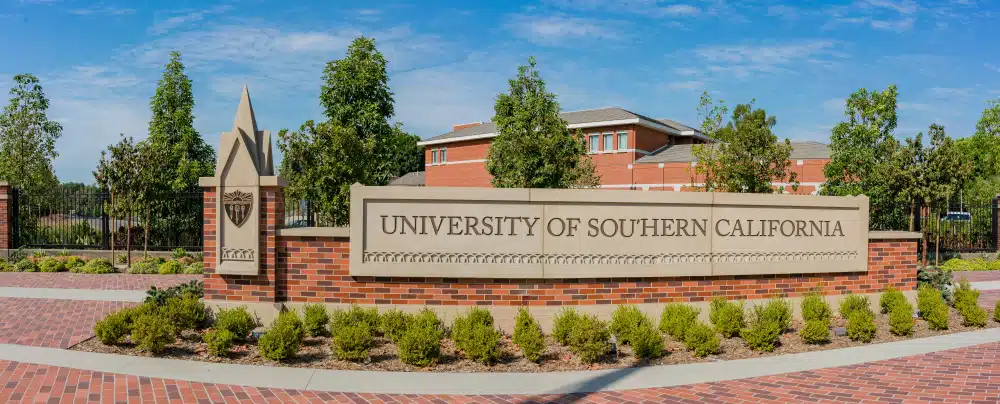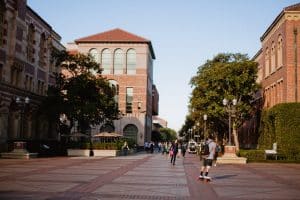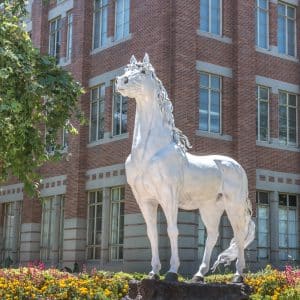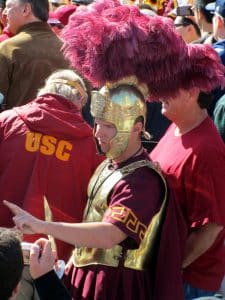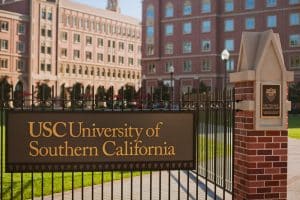Discovering How Big USC Is
The University of Southern California (USC) is not only known for its prestigious academic programs but also for its sprawling campus and vibrant student population. Understanding the size of USC, both in terms of physical space and student body, is key to grasping the magnitude of this renowned institution.
Understanding the Size of USC
USC’s campus is a sight to behold. Stretching across 226 acres in the heart of Los Angeles, it features a combination of modern facilities and historic buildings that reflect the university’s rich heritage. To truly appreciate the campus’s scale, one must consider the aerial view and statistics.
As you soar high above USC, taking in the panoramic view, you can’t help but be amazed by the sheer size of the campus. The sprawling landscape is dotted with over 400 buildings, each with its own unique architectural style and purpose. From state-of-the-art research facilities to beautifully landscaped gardens, there is no shortage of architectural wonders to admire.
But it’s not just about the physical structures that define USC’s campus. The university is proud of its lush green spaces, which cover over 33 acres. These open areas provide a tranquil setting for students to relax and recharge amidst the bustling urban environment. Imagine strolling through these green oases, surrounded by towering trees and vibrant flowers, finding solace in nature’s embrace.
The Campus: Aerial View and Statistics
Now, let’s delve deeper into the statistics that make USC’s campus truly impressive. With over 400 buildings, it’s no wonder that the university is a hub of activity and innovation. These buildings house a wide range of academic departments, research centers, and administrative offices, all working together to create a vibrant intellectual community.
But it’s not just the number of buildings that sets USC apart. The university is home to over 100 research centers and institutes, each dedicated to pushing the boundaries of knowledge and making groundbreaking discoveries. From exploring the depths of the ocean to unraveling the mysteries of the human brain, USC’s research facilities are at the forefront of innovation.
And let’s not forget about the world-class sports facilities that USC proudly boasts. Among them is the legendary Los Angeles Memorial Coliseum, a historic stadium that has witnessed countless thrilling moments and intense rivalries. Home to the Trojans football team, this iconic venue is a symbol of USC’s athletic prowess and rich sporting tradition.
Number of Buildings and Facilities
As you explore USC’s vast campus, you’ll find that every nook and cranny is brimming with opportunities for students to pursue their passions. The university offers a wide range of facilities, from libraries to laboratories, residence halls to performance spaces.
Step inside the libraries, and you’ll be greeted by rows upon rows of books covering a vast array of subjects. These libraries are not just repositories of knowledge but also vibrant spaces for intellectual exploration and collaboration.
In the laboratories, students and researchers work side by side, conducting experiments and pushing the boundaries of scientific understanding. From chemistry to biology, physics to engineering, USC’s labs are buzzing with activity and innovation.
Residence halls provide a home away from home for students, fostering a sense of community and camaraderie. Here, lifelong friendships are formed, late-night study sessions take place, and memories are made.
And let’s not forget about the performance spaces. From grand theaters to intimate concert halls, USC’s campus is a haven for the arts. Whether it’s a captivating play, a mesmerizing dance performance, or a soul-stirring musical concert, these venues come alive with creativity and talent.
So, as you navigate USC’s expansive campus, take the time to explore its diverse buildings and facilities. From the towering research centers to the inviting residence halls, each space has its own story to tell and its own role to play in shaping the university’s vibrant community.
Analyzing USC’s Student Population
No discussion about USC’s size would be complete without acknowledging its diverse and dynamic student body. The university attracts students from all walks of life, both domestic and international, who contribute to the vibrant tapestry that makes up the USC community.
USC’s student population is not only large but also incredibly diverse. The university prides itself on its ability to attract students from various backgrounds, creating a rich and multicultural environment. Students come from different states across the United States, bringing with them their unique perspectives and experiences. This diversity allows for a truly immersive and inclusive educational experience.
Moreover, USC’s global reputation attracts students from all corners of the world. International students, hailing from over 115 countries, choose USC as their educational destination, drawn by the university’s academic excellence and the opportunities it offers. These international students bring with them a wealth of cultural knowledge and experiences, further enhancing the global atmosphere on campus.
Undergraduate and Graduate Numbers
At USC, undergraduate students form a significant part of the student population. Currently, there are over 20,000 undergraduates enrolled in a wide range of academic disciplines. These students benefit from small class sizes and close faculty mentorship, fostering an environment conducive to learning and personal growth.
USC’s undergraduate programs are designed to provide students with a well-rounded education. The university offers a diverse range of majors and minors, allowing students to explore their interests and passions. From business to engineering, from the arts to the sciences, USC offers a comprehensive undergraduate education that prepares students for success in their chosen fields.
Additionally, USC’s graduate programs are highly regarded and attract students from around the world. With more than 27,000 students pursuing advanced degrees across various fields, USC provides a platform for groundbreaking research and innovation. Graduate students collaborate with renowned faculty to address pressing societal issues and push disciplinary boundaries, making significant contributions to their respective fields.
International Student Statistics
USC prides itself on being a globally diverse institution. With students representing over 115 countries, the university cultivates an international atmosphere that fosters cross-cultural learning and understanding. International students comprise nearly 15% of the total student population, contributing their unique perspectives and enriching the USC experience for all.
International students at USC not only bring cultural diversity but also contribute to the academic and research landscape. These students often bring different educational backgrounds and perspectives, which can lead to innovative approaches to problem-solving and collaboration. USC’s commitment to global engagement is further strengthened by its partnerships with universities and institutions around the world, creating opportunities for international exchange and collaboration.
Furthermore, USC provides extensive support services for international students, ensuring a smooth transition and integration into campus life. From orientation programs to academic advising, USC strives to create a welcoming and inclusive environment for all students, regardless of their country of origin.
Delving into USC’s Academic Scope
Beyond its physical size and student population, USC’s academic scope is equally impressive. The university offers a wide array of academic departments and programs, ensuring that students can pursue their passions and explore new intellectual frontiers.
When it comes to academic departments and programs, USC truly stands out. With over 20 professional schools and various interdisciplinary departments, the university caters to a diverse range of academic interests. Students have the opportunity to delve into fields such as business, engineering, arts, sciences, and more. Each academic unit contributes to USC’s reputation as a hub of intellectual excellence, providing students with the resources and support they need to thrive.
The prestigious Marshall School of Business is renowned for its rigorous curriculum and world-class faculty. Students have the chance to learn from industry leaders and gain practical skills that will prepare them for successful careers in the business world. The Viterbi School of Engineering, on the other hand, is known for its cutting-edge research and innovative approach to engineering education. Students have access to state-of-the-art facilities and collaborate with faculty who are at the forefront of technological advancements.
However, USC’s academic offerings go beyond traditional disciplines. The university also embraces interdisciplinary programs, such as the Iovine and Young Academy for Arts, Technology, and the Business of Innovation. This unique program brings together students from diverse backgrounds, encouraging collaboration and innovation between different areas of study. By combining art, technology, and business, students in this program develop a well-rounded skill set that prepares them for the ever-evolving demands of the creative industries.
Research Opportunities and Achievements
Research is a cornerstone of USC’s academic agenda, and the university has a long history of groundbreaking discoveries and transformative achievements. USC’s commitment to research is evident in its ample funding opportunities and state-of-the-art facilities, which provide students with the tools they need to pursue their research interests.
Whether it’s in the field of science, humanities, or the arts, USC continually pushes the boundaries of knowledge and creativity through its research endeavors. Faculty and students collaborate on projects that have real-world impact, from developing life-saving medical treatments to creating thought-provoking works of art. The university’s research output and influential faculty have contributed to its recognition as one of the top research institutions globally.
USC’s research opportunities extend beyond the campus borders. The university actively encourages students to engage in internships and collaborations with industry partners, allowing them to apply their knowledge and skills in real-world settings. This hands-on approach to research not only enhances students’ learning experience but also opens doors to exciting career opportunities.
Furthermore, USC’s commitment to research extends to undergraduate students as well. The university offers numerous research programs and initiatives specifically designed for undergraduates, providing them with the opportunity to work alongside faculty mentors and contribute to cutting-edge research projects. This early exposure to research not only prepares students for advanced studies but also instills in them a lifelong passion for inquiry and discovery.
Exploring USC’s Athletic Prowess
USC’s impact extends far beyond the confines of its academic endeavors. The university’s athletic prowess is legendary, with a rich history of success in collegiate sports.
When it comes to sports, USC is a force to be reckoned with. The university’s sports teams have a long-standing tradition of excellence, consistently ranking among the top in the nation. From the iconic Trojan Marching Band to the Trojan athletes who compete at the highest level, USC’s sports teams are an integral part of the university’s identity.
Let’s take a closer look at some of USC’s most notable sports teams and their achievements. The football program, for example, has a storied history, with multiple national championships under its belt. The Trojans have produced some of the greatest football players of all time, including Heisman Trophy winners and NFL superstars.
But football is not the only sport where USC shines. The basketball program has also made its mark, with a strong presence in both the men’s and women’s divisions. The Trojans have had numerous successful seasons, making appearances in the NCAA tournament and producing talented players who have gone on to have successful careers in the NBA and WNBA.
And let’s not forget about baseball. USC’s baseball program has a rich history of success, with multiple College World Series championships to its name. The Trojans have consistently produced top-tier talent, with many players going on to have successful careers in Major League Baseball.
In addition to the impressive sports teams, USC’s athletic facilities provide a world-class environment for training and competition. The university boasts state-of-the-art stadiums, arenas, and training centers that rival those of professional sports teams. These facilities not only provide a top-notch experience for the athletes but also create an electrifying atmosphere for fans who come to support their beloved Trojans.
One of the standout facilities is the Heritage Hall, a state-of-the-art sports museum that pays homage to the university’s athletic legacy. Inside, visitors can explore the rich history of USC sports, from the early days of the university’s athletic program to the modern era of championships and triumphs. The museum showcases memorabilia, trophies, and interactive exhibits that capture the essence of what it means to be a Trojan athlete.
But USC’s impact in collegiate athletics goes beyond just winning championships and having impressive facilities. The university is committed to promoting sportsmanship, teamwork, and leadership among its student-athletes. Through programs like the “I am a Trojan” initiative, USC nurtures the personal and professional development of its student-athletes, empowering them to become leaders on and off the field.
USC’s dedication to academic success is also a cornerstone of its athletic program. The Student-Athlete Academic Services Center ensures that student-athletes receive the support they need to excel both on the field and in the classroom. Academic advisors work closely with athletes to help them balance their rigorous training schedules with their academic responsibilities, ensuring that they have the tools and resources to succeed in all aspects of their lives.
With its rich athletic history, world-class facilities, and commitment to developing well-rounded student-athletes, USC continues to make a lasting impact in the world of collegiate athletics. The university’s athletic prowess, combined with its academic excellence, sets the stage for a truly exceptional student experience and a solid foundation for future success.
USC’s Influence on the Community
As a major institution in Los Angeles, USC holds a significant role in shaping the local community and contributing to its growth and well-being.
USC’s Economic Impact
The university serves as an economic anchor in the region, driving job creation and fostering economic development. With a yearly economic impact of over $8 billion, USC’s activities have ripple effects that spread far beyond the confines of its campus.
Additionally, USC’s commitment to supporting local businesses and creating partnerships with nearby communities strengthens the social fabric of the region, fostering a symbiotic relationship between the university and the broader community.
Community Outreach and Programs
USC’s influence extends beyond its academic and athletic endeavors. The university actively engages with nearby communities through various outreach programs, addressing social issues and fostering positive change.
From initiatives that promote education and health to partnerships that support entrepreneurial growth and cultural enrichment, USC’s community outreach programs embody the university’s dedication to being a responsible and impactful institution.
Final Thoughts
USC’s multi-faceted size encompasses its sprawling campus, diverse student population, extensive academic offerings, athletic achievements, and community impact. The University of Southern California’s commitment to excellence in every aspect of its operations has solidified its standing as a prominent global institution.
How AdmissionSight Can Help You With College Admissions
AdmissionSight is a college consulting firm that provides personalized assistance to students throughout the college admissions process. Here are some ways that AdmissionSight can help you:
Admissions strategy: AdmissionSight can help you develop a strategic plan for your college application process. Our professional consultants can assist with identifying schools that are a good fit for your academic, extracurricular, and personal goals and help you plan and prioritize your application strategy.
Application review: AdmissionSight can review your application and provide feedback on how to improve it. We can offer suggestions on making your application stand out and highlighting your strengths and unique qualities.
Essay coaching: AdmissionSight can help you craft compelling essays that showcase your personality, goals, and achievements. We can guide you through the essay writing process and provide feedback on your drafts to help you refine your writing.
Interview preparation: AdmissionSight can provide interview coaching to help you feel confident and prepared for college interviews. Our experts can offer tips on how to present yourself professionally and how to answer common interview questions.
Extracurricular planning: AdmissionSight can help you plan and develop your extracurricular activities to make them more impactful and meaningful. We can suggest activities that align with your interests and goals and provide guidance on demonstrating your leadership and initiative.
Overall, AdmissionSight can provide valuable guidance and support throughout the college admissions process to help you maximize your chances of getting accepted into the college of your choice.
With a high success rate of over 75%, we have built a strong network in the past decade. Book an initial consultation today, free of charge!



